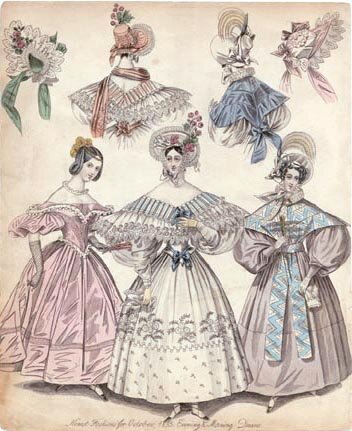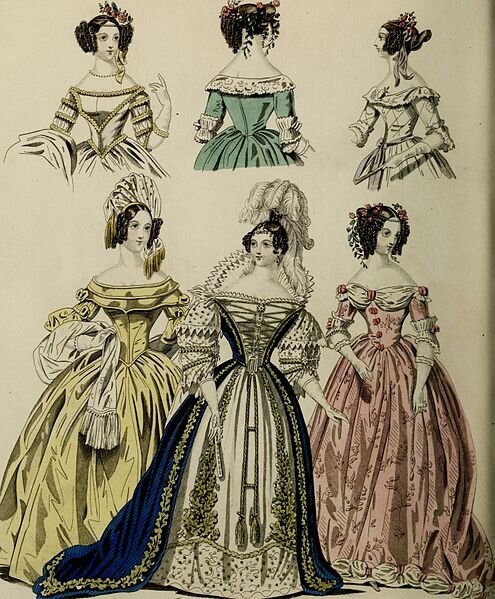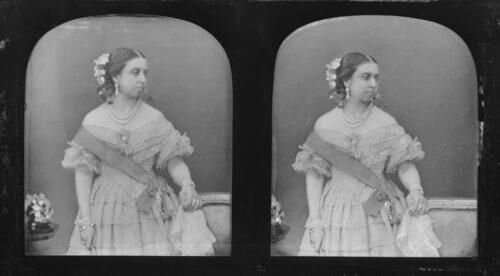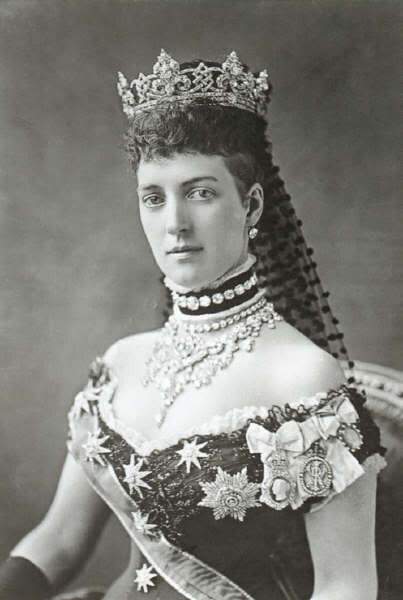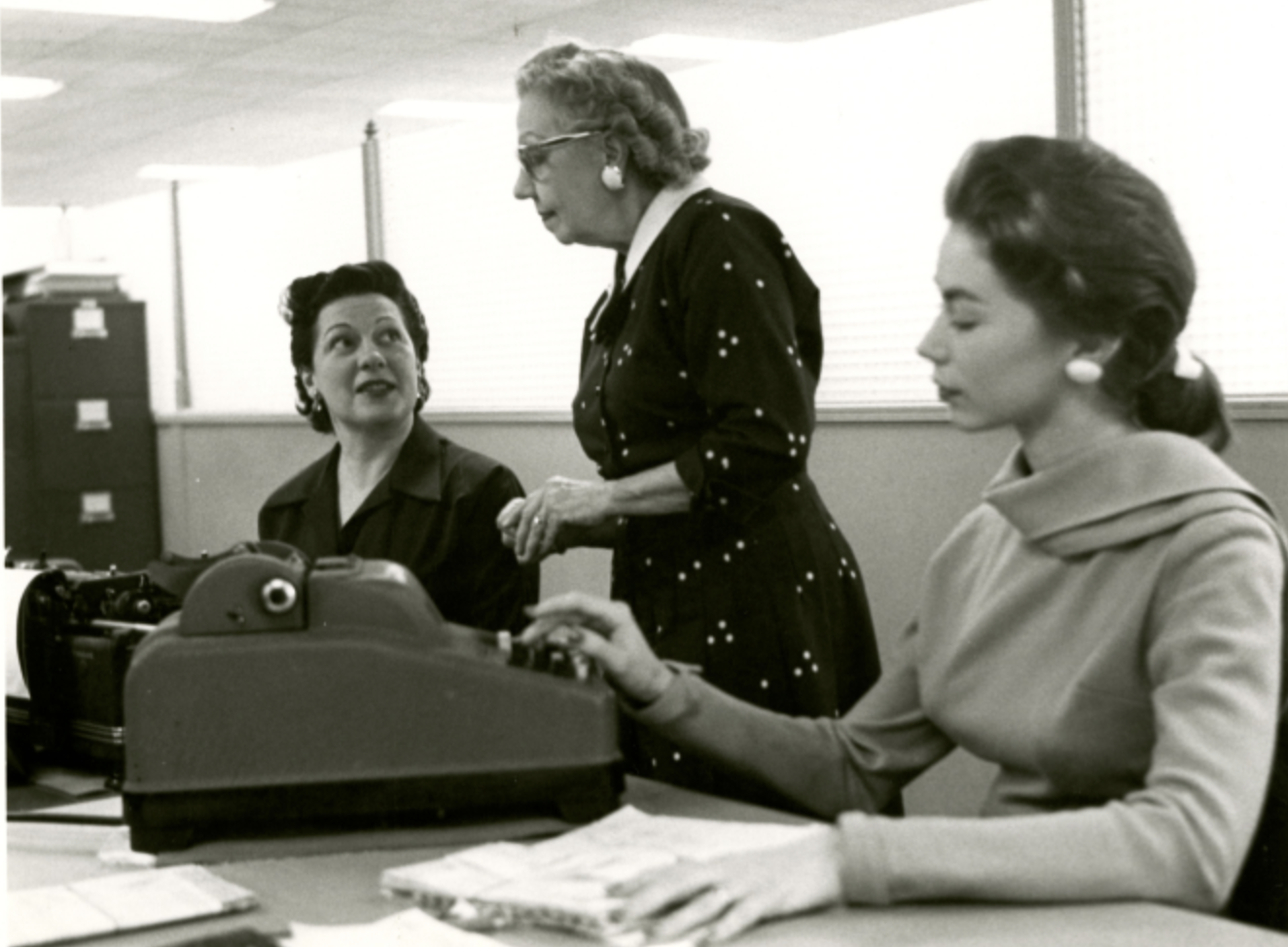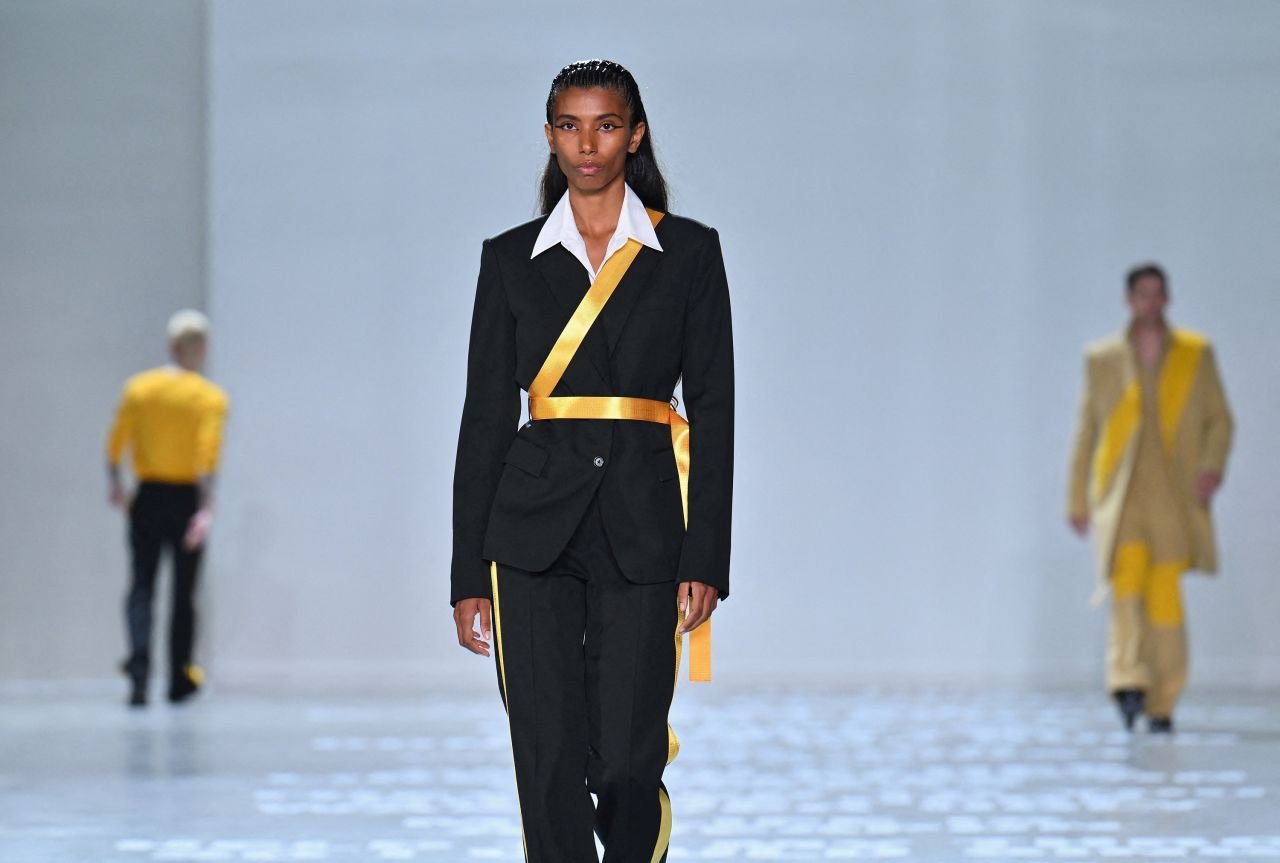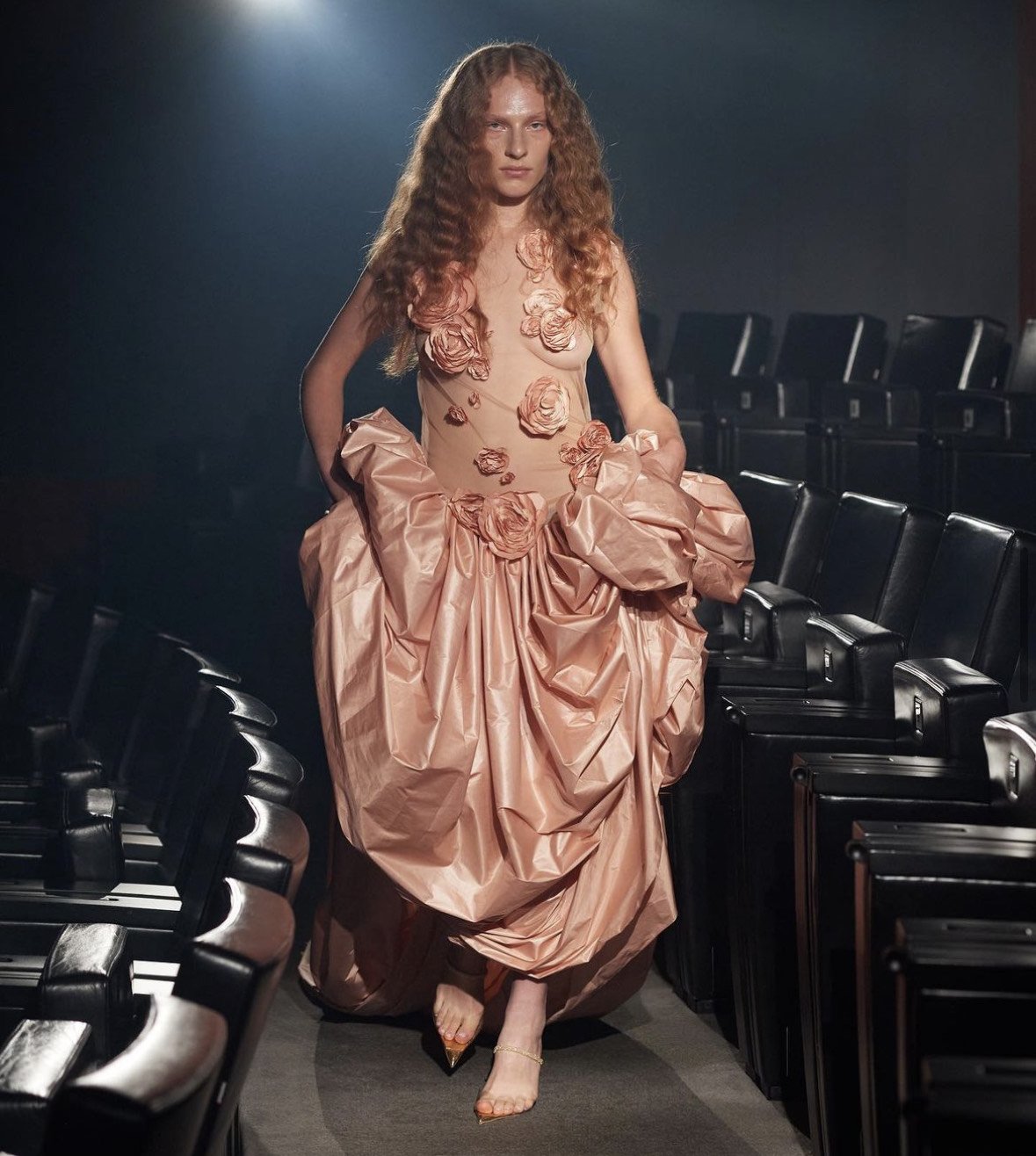Victorian Fashion And Its Royal Influences
When Queen Victoria ascended to the throne in 1837, having just turned 18 years old, she was full of the joys of youth and enjoyed popular fashions. As her 63 year-long reign progressed her fashion choices greatly influenced those of her subjects. Like most women of her time, Victoria tried to dress to please the men in her life and her first Prime Minister, Lord Melbourne, would often advise her on what to wear. Prince Albert would later do the same. As any British monarch should, Victoria requested that all her clothes, and the clothes worn by those in her court, be of British manufacture. She always set the trends, particularly in the earlier half of her reign. So, let’s take a brief look at the fashions of the Victorian era and how Victoria and her family helped shape them.
1830s
I like to say that the 1830s were the 80s of the 19th century, meaning it was the decade of over the top, ridiculous shapes and huge sleeves! 1830s fashion is generally characterised with an emphasis on width, at the shoulders as well as the hips. This was in stark contrast to the much narrower silhouettes of the previous two decades, which favoured more natural and toned down shapes.
1833 Fashion Plate Credit: University of Washington fashion plate collection
At the beginning of the decade dresses with gigot sleeves were highly popular and dresses would often be accessorised with a buckle or sash tie. It may surprise you, but in the 1830s dresses would often be ankle length - how saucy! However, around 1935, skirt lengths for women of higher society dropped to floor length. The 1830s brought new innovations in textiles technology, introducing new dress fabrics. Elegant and delicate floral prints on pale backgrounds were increasing in popularity and new green dyes appeared on floral patterns. Heavy and stiff fabrics like brocade came back into style for the first time since the 18th century, and many brought old 18th-century gowns down from storage and cut them up into new garments. I really wish they hadn’t because then we would probably have far more extant 18th-century gowns, but alas.
1836 Evening gown fashion plate
Evening gowns of the decade generally had wide necklines and short, puffed sleeves that reached to the elbow from a dropped shoulder. They were often accessorised with mid-length gloves. As the decade drew to a close, and a young Victoria became Queen, the extravagant styles of the 1830s began to quieten down and become more subdued.
Princess Victoria and her dog Dash 1833 by George Hayter
1840s
The 1840s saw fashions shift towards a more subtle and minimalist style. A natural shoulder line came into fashion and the waistline of dresses dropped for both men and women, drawing into a point, forming a triangle from the shoulder to the waist of day dresses.
1844 fashion plate
Skirts began to evolve to a bell shape from the conical shape of the previous decade, which was aided by the new method of attaching skirts to bodices using cartridge pleats. Cartridge pleating would become synonymous with 1840s fashion. And as skirts became fuller, women had to start wearing more layers of starched petticoats, a bothersome affair which would lead to the invention of the crinoline in the 1850s (more on this later.)
1844 evening gowns
1840s evening gowns were worn off the shoulder, like the 1830s, and featured wide flounces of fabric that reached to the elbow. Women would often accessorise with shawls and opera-length gloves. Queen Victoria wore the fashionable silhouette of the 1840s and helped promote new fashions of the decade in what she chose to wear. Many portraits of a young Queen Victoria show her with hair parted in the centre, with two plaits looped up into a neat bun on the back of her head. This was a hairstyle that was incredibly popular in the 1840s, and Her Majesty certainly helped popularise it.
Queen Victoria photographed in 1840
The 1840s was also the first decade of photography, and Victoria and her husband Albert were early adopters of this new art. For the first time in history we can see first-hand images of what the Queen and members of her court chose to wear, and not only portraits and drawings which are often exaggerated. When Queen Victoria married Prince Albert of Saxe-Coburg and Gotha in February 1840, she chose to wear a white wedding dress. To us, in 21st-century western culture, this seems completely normal, but in fact, Victoria was doing something highly unusual.
Victoria and Albert on their wedding day
During this time, brides tended to wear brighter colours for their wedding, or simply whatever they owned that they deemed appropriate. Her dress was made of heavy silk satin and featured Honiton lace, which helped to boost Devon lace-making. Victoria wasn’t the first Royal bride in history to wear white for her wedding, but she clearly made a great impact as wearing white was quickly adopted by the wealthy elite and has stayed a tradition ever since.
1850s
The 1850s saw the skirts of the 1840s continue to expand, becoming fuller and fuller by way of ruffles, that were usually in tiers of three. This increase in the width of women’s skirts led to the introduction of the steel cage crinoline in 1856, which allowed for the use of fewer petticoats.
1850s day dress
As the decade progressed, flounces and ruffles slowly started disappearing, being replaced with skirts that lay more smoothly over the petticoat and crinoline. The natural sleeves of the 1840s evolved into wider bell-shaped or pagoda sleeves and they were often detailed with lace. A fashionable way to accessorise one’s seemingly plain day dress was by using separate small, dainty lace collars. Day dresses were commonly made from linen or cotton, with patterns often in gingham, checks and plaids, reflecting the conservative style of Queen Victoria and her nation.
English Lady 1850s
Victoria was known for favouring modesty and minimalism, and this is clearly visible in fashion when she was at the height of her influence. The conservative fashions of the 40s and 50s with Victoria at the helm of fashion are in stark contrast to the 60s onwards where Princess Alexandra was a fashion icon. Another fashion trend of the 1850s was the basque waist, which was a hip-length jacket that fitted tightly over the bosom and waist and flared over the hips, reminiscent of riding habits. Evening gowns of the decade were again low necked, off the shoulder and had short sleeves.
1860s
The first couple of years of the 1860s saw skirts reach their eventual width, however, after around 1862, the silhouette of the crinoline developed and rather than being bell-shaped, it flattened slightly at the front and began to project more behind. We are now starting to see a gradual move towards the bustle.
1864 fashion plate
These new skirts were more elaborate, being covered in flounces, puffs and lace, sometimes obscuring all views of the fabric beneath! Overskirts gained popularity in the 1860s, revealing contrasting materials of the underskirt. This is a style that would continue to gain popularity right through the bustle eras of the next two decades. The first chemical dyes were discovered in 1856 and quickly became fashionable, with magenta being popularized in England by the Duchess of Sutherland after she wore Spitalfields silk in this shade. It is interesting to note that fashions were adopted more slowly in America than Europe, with fashion plates from Europe appearing in America a year or more later, cementing the fact that England was at the forefront of 19th-century western fashions.
Journal des Demoiselles, Ocober 1860.
Englishmen Charles Frederick Worth established his fashion house in 1858 in Paris, and he would become the first dressmaker to be considered an artist. His style and influence in the 1860s led to the dominance of Parisian haute couture which is still popular today. Prince Albert tragically died in 1861, plunging Queen Victoria into deep mourning, from which she would never emerge. It is at this point that Victoria stopped trying to follow the ever changing styles of fashion and instead chose to adopt a widow’s uniform, which would go on to become her trademark style.
Queen Victoria in Mourning dress 1873. Credit: Hulton Archive/Getty Images
She wore full-skirted black gowns that buttoned down the front and would complete the look with a white cap. As was customary in Victorian mourning dress, Victoria’s dresses were made in heavy crepe fabric, however, as the years progressed she would instead favour lighter silks. As the Queen withdrew from public view it became increasingly clear that she was no longer going to be a fashion inspiration, instead, the public turned to her daughters and future daughters-in-law for inspiration.
1870s
The 1870s saw the fashions of the Victorian era shift dramatically, beckoning in a new silhouette, the bustle. At the end of 1860s, fullness in the skirt had carried on moving to the rear where large overskirts now had to be supported by means of a bustle.
1870s fashion plate
This was a padded undergarment, worn under the skirt and just below the waist. Day dresses had high necklines, almost similar to day dresses of the Edwardian era, that could be closed or quite commonly squared shaped and featured elaborate decorations of flounces and bows. Skirts could also be rather long, featuring a small train. The billowy sleeves of previous decades were long gone and narrow, tight, sleeves were now de rigueur.
Bustle dress from 1870
Evening gowns retained a low neckline and featured short, off the shoulder sleeves. The 1870s advanced alongside the influence of the Pre-Raphaelite Brotherhood and other artistic reforms, bringing along a new fashion for uncorseted lines and more natural silhouettes. This led to the creation of the tea gown, a loose-fitting gown worn around the house during afternoon tea and when entertaining guests. It was semi-formal and seen as respectable to be seen among friends.
Alexandra, Princess of Wales 1870
Queen Victoria’s style influence was long gone and the stunning Alexandra, Princess of Wales, was the new fashion influencer. She popularised the Robe a la Princesse, a gown featuring a slim waist at its natural level and flowing lines that were in stark contrast with the crinolines of the previous decade and from 1875 this is a style followed by many, leading to the natural form era of the late 1870s.
Natural form era dress
1878 saw the bustle fall out of favour, with women instead wearing small bum pads, although this was a highly popular trend it only lasted about 4 years. Alexandra was known for being a lover of Parisian haute couture and would often stray from wearing purely British fabrics, she was wholly different from the Queen, and the public was beguiled by her beauty and passion for fashion.
1880s
The natural form era was short-lived and as the 1880s were born the bustle returned, however this time the silhouette was slightly changed. A fuller, curvier shape with widening shoulders was increasingly more prominent, and fashionable waists were now low being supported by a low bust corset.
1885 fashion plate
This new bustle era featured a bustle that was more like a shelf on one’s bottom, and it was rigid and stiff unlike the softer, draped bustle of the 1870s. The fullness in the back of gowns had to be balanced, and this was achieved via a new corset silhouette, one which closely resembles that of the Edwardian S-bend or health corset, a fashion which raised eyebrows from some. Unlike skirts of the previous decade, 1880s gowns generally did not feature a long train, instead, they were tight, with some being known as hobble-skirts, as they restricted the wearer from walking easily. As we have established by now, evening gowns were still low-necked and 1880s evening gowns were sleeveless.
Alexandra, Princess of Wales 1881
Princess Alexandra, the future Queen Alexandra, was still a doyenne for fashion. She had a scar on her neck which she chose to hide under layers of choker necklaces and jewelled collars, a habit she would retain for her whole life, and by doing so she promoted the use of such necklaces. Around 1888 the bustle slowly began to diminish in size until it practically disappeared, clearing the path for the bell-shaped skirts of the 1890s.
1890s
The 1890s saw a boom in technology with the introduction of electricity into the making of clothes, creating an explosion of the ready-to-wear market. With clothing starting to be produced en masse, fashions became easier to follow for all sectors of society, and it was no longer just the upper class who were the most fashionable. The early years of the decade saw silhouettes remain a continuation of the late 1880s, and the puff-sleeved began to develop.
1892 fashion plate
However, with the disappearance of the bustle in 1892, skirts became bell-shaped, fitted with gores to smoothly fit over the hips, and large leg-o-mutton sleeves came into being. The width of the top and bottom of these 1890s gowns had to be balanced, and so a nipped-in waist and hourglass figure was most desired. As the 19th century drew slowly to a close, women found themselves gaining more freedom and the invention of the drop-frame safety bicycle allowed women the ability to ride bikes far more comfortably, and thus sportswear for women arose.
1897 John Singer Sargent oil painting. Credit: Met Museum of Art
New, tailored clothes adapted from men’s clothing were now worn by women for outdoor activities and travelling. The shirtwaist was now seen as acceptable clothing for women and were matched with ankle-length walking skirts, a style that would carry on well into the Edwardian era. Evening gowns tended to be open at the neck and featured a wasp-waist cut and skirts with long trains, a style commonly seen in Worth gowns. With the introduction of the straight-front corset in around 1897, the silhouette began to shift into what we now recognise as Edwardian.
So, the Victorian era took us from the excesses of the 1830s to the simpler and freer style of the 1890s. The influence of the Queen and her daughter in law, Princess Alexandra, was clearly very strong although their fashion styles could be said to be diametrically opposed. However, the introduction of photography helped create much more aspirational influence as the general public could see the Royals more often, even if only in print. This influence of course continues to this day as the public looks for fashion hints from members of the Royal family and celebrities alike.
